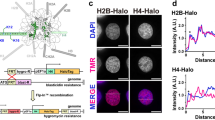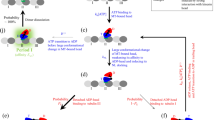Abstract
DURING cell division, sister chromosomes segregate from each other on a microtubule-based structure called the mitotic spindle. Proteins bind to the centromere, a region of chromosomal DNA, to form the kinetochore, which mediates chromosome attachment to the mitotic spindle microtubules1,2. In the budding yeast Sac-charomyces cerevisiae, genetic analysis has shown that the 28-base-pair (bp) CDEIII region of the 125-bp centromere DNA sequence (CEN sequence) is the main region controlling chromosome segregation in vivo3,4. Therefore it is likely that proteins binding to the CDEIII region link the centromeres to the microtubules during mitosis. A complex of proteins (CBF3) that binds specifically to the CDEIII DNA sequence has been isolated by affinity chromatography5. Here we describe kinetochore function in vitro. The CBF3 complex can link DNA to microtubules, and the complex contains a minus-end-directed microtubule-based motor. We suggest that microtubule-based motors form the fundamental link between microtubules and chromosomes at mitosis.
Similar content being viewed by others
References
Rieder, C. L. Chromosoma 84, 145–158 (1981).
Roos, U. P. Chromosoma 41, 195–220 (1973).
McGrew, J. B. D. & Fitzgerald-Hayes, M. Molec. cell. Biol. 6, 530–538 (1986).
Ng, R. & Carbon, L. Molec. cell. Biol. 7, 4522–4534 (1987).
Lechner, J. & Carbon, J. Cell 64, 717–726 (1991).
Clarke, L. Trends Genet. 6, 150–154 (1990).
Hyman, A. A. J. Cell Sci. 14 (suppl.), 125–127 (1991).
Hyman, A. A. & Mitchison, T. J. Nature 351, 206–211 (1991).
Rieder, C. L. & Alexander, S. P. J. Cell Biol. 110, 81–95 (1990).
Pfarr, C. M. et al. Nature 345, 263–265 (1990).
Steuer, E. R., Wordeman, L., Schroer, T. A. & Sheetz, M. P. Nature 345, 266–268 (1990).
Walker, J. W., Reid, G. P. & Trentham, D. R. Meth. Enzym. 172, 288–301 (1989).
Vallee, R. B. & Shpetner, H. S. A. Rev. Biochem. 59, 909–932 (1990).
Shimizu, T. et al. J. Cell Biol. 112, 1189–1197 (1991).
Euteneuer, U., Jackson, W. T. & McIntosh, J. R. J. Cell Biol. 94, 644–653 (1982).
Yamamoto, A., Nagai, K., Yamasaki, M. & Matsuhashi, M. Cell Struc. Func. 15, 221–228 (1990).
Peterson, J. B. & Ris, H. J. Cell Sci. 22, 219–242 (1976).
Palmer, R. E., Koval, M. & Koshland, D. J. Cell Biol. 109, 3355 (1990).
Switzer, R. C., Meril, C. R. & Shifin, S. Analyt. Biochem. 98, 231 (1979).
Block, S. M., Goldstein, L. S. B. & Schnapp, B. J. Nature 348, 348–352 (1991).
Author information
Authors and Affiliations
Rights and permissions
About this article
Cite this article
Hyman, A., Middleton, K., Centola, M. et al. Microtubule-motor activity of a yeast centromere-binding protein complex. Nature 359, 533–536 (1992). https://doi.org/10.1038/359533a0
Received:
Accepted:
Issue Date:
DOI: https://doi.org/10.1038/359533a0
- Springer Nature Limited
This article is cited by
-
A cell-free system for functional centromere and kinetochore assembly
Nature Protocols (2012)
-
Ndc10 is a platform for inner kinetochore assembly in budding yeast
Nature Structural & Molecular Biology (2012)
-
The life and miracles of kinetochores
The EMBO Journal (2009)
-
Boveri revisited
The EMBO Journal (2005)
-
Rings around kinetochore microtubules in yeast
Nature Structural & Molecular Biology (2005)





